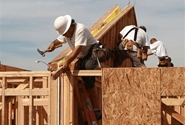Analysis

June 19, 2018
Housing Starts Increase in May, But Permits Decline
Written by Sandy Williams
Housing starts rose 5.0 percent in May to a seasonally adjusted annual rate of 1,350,000, the highest level since July 2007, according to data from the Commerce Department. Starts were 20.3 percent above the rate in May 2017.
Single-family housing starts rose 3.9 percent from April and multi-family housing of five units or more jumped 11.3 percent. Starts jumped 62.2 percent in the Midwest, but declined across the other regions.
Permits authorization, a predictor of future construction, dropped 4.6 percent in May to a seasonally adjusted annual rate of 1,301,000. Authorizations were 8.0 percent higher than the year-ago rate of 1,205,000.
Single-family authorizations slid 2.2 percent from the previous month, while permits for housing of five units or more fell 8.5 percent. Authorizations rose in the Northeast and Midwest by 42.1 percent and 7.2 percent, respectively, but dropped 13.9 percent in the South and 4.6 percent in the West.
“Ongoing job creation, positive demographics, and tight existing home inventory should spur more single-family production in the months ahead,” said NAHB Chief Economist Robert Dietz. “However, the softening of single-family permits is consistent with our reports showing that builders are concerned over mounting construction costs, including the highly elevated prices of softwood lumber.”
The U.S. imposed lumber tariffs on Canadian softwood lumber in April 2017. According to data from NAHB, record-high lumber prices have added $9,000 to the price of new homes since the beginning of last year.







